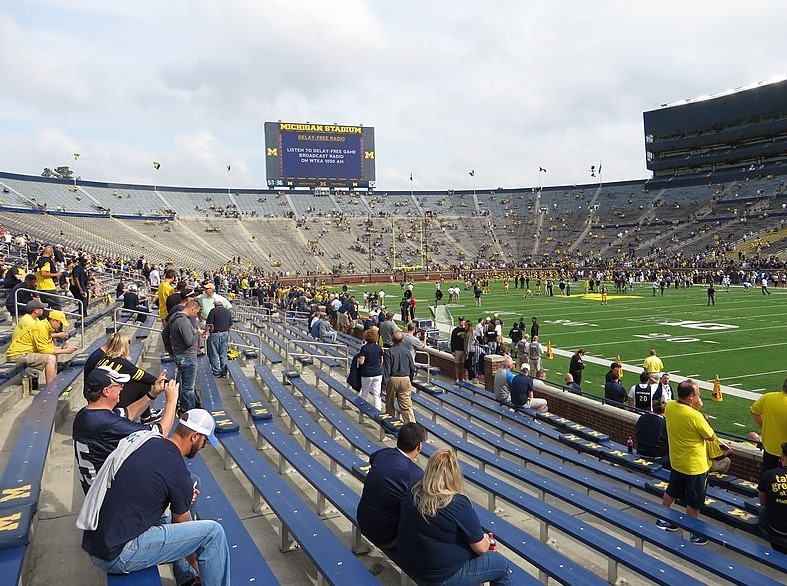Michigan Stadium

It is the biggest arena in the United States, the third largest arena in the world and the 34th largest sports venue. It has actually hosted crowds in excess of 115,000.
Michigan Stadium was built in 1927 at a cost of $950,000 (equivalent to $11.2 million in 2018 and had an initial capacity of 72,000. Prior to the arena’s building, the Wolverines played football at Ferry Field. Every home game since November 8, 1975 has actually drawn a crowd in excess of 100,000, an active streak of more than 200 contests. On September 7, 2013, the video game in between Michigan and the Notre Dame Fighting Irish attracted a crowd of 115,109, a record presence for a college football game since 1948, and an NCAA single-game attendance record at the time, surpassing the previous record of 114,804 set 2 years formerly for the very same matchup.
Michigan Stadium was designed with footings to permit the stadium’s capability to be broadened beyond 100,000. Fielding Yost pictured a day where 150,000 seats would be required. To keep building and construction costs low at the time, the choice was made to develop a smaller sized arena than Yost imagined but to consist of the footings for future expansion.
Michigan Stadium is utilized for the University of Michigan’s main graduation events; President Lyndon B. Johnson described his Great Society program at the 1964 commencement ceremonies in the stadium. It has likewise hosted hockey video games consisting of the 2014 NHL Winter Classic, a regular season NHL video game in between the Toronto Maple Leafs and the Detroit Red Wings with an authorities attendance of 105,491, a record for a hockey game. Furthermore, a 2014 International Champions Cup soccer match in between Real Madrid and Manchester United had a participation of 109,318, a record crowd for a soccer match in the United States. Ann Arbor Michigan Information.
| Location | 1201 South Main Street Ann Arbor, Michigan 48104-3722 |
|---|---|
| Coordinates | 42°15′57″N 83°44′55″WCoordinates: 42°15′57″N 83°44′55″W |
| Owner | University of Michigan |
| Operator | University of Michigan |
| Capacity | 72,000 (1927) 85,752 (1928–1948) 97,239 (1949–1955) 101,001 (1956–1972) 101,701 (1973–1991) 102,501 (1992–1997) 107,501 (1998–2007) 106,201 (2008–2009) 109,901 (2010–2015) 107,601 (2015–present) |
| Record attendance | 115,109 (September 7, 2013) |
| Surface | FieldTurf (2003–present) Natural grass (1991–2002) Artificial turf (1969–1990) Natural grass (1927–1968) |
| Construction | |
| Broke ground | September 12, 1926 |
| Opened | October 1, 1927 (92 years ago) |
| Renovated | 2010 |
| Expanded | 1928, 1949, 1956, 1973, 1992, 1998, 2010 |
| Construction cost | $950,000 ($11.2 million in 2018) $226 million (2010 stadium renovation, equivalent to $270 million in 2018) |
| Architect | Bernard L. Green HNTB (2010 expansion) |
| General contractor | James Leck Company |
| Tenants | |
| Michigan Wolverines football (NCAA) (1927–present) Michigan Wolverines field hockey (NCAA) (1973–1975) Michigan Wolverines men’s lacrosse (NCAA) (2012–present) Michigan Wolverines women’s lacrosse (NCAA) (2014–present) |
|
Early history
Prior to dipping into Michigan Stadium, Michigan played its games at Ferry Field, which at its peak could seat 40,000 people. Fielding Yost acknowledged the need for a larger stadium after original expansions to Ferry Field proved to be too little, and encouraged the regents to construct a permanent arena in 1926. Made after the Yale Bowl, the original arena was constructed with a capacity of 72,000. At Yost’s advising, momentary bleachers were added at the top of the stadium, increasing capability to 82,000.
On October 1, 1927, Michigan played Ohio Wesleyan in the very first video game at Michigan Stadium, dominating quickly, 33– 0. Michigan had ruined the official devotion of Ohio Stadium in Columbus 5 years previously and was triumphant again, besting the Buckeyes 21– 0 before a standing-room-only crowd of 84,401. In 1930, electronic scoreboards were installed, making the arena the first in the United States to use them to keep the main game time.
In 1956, the addition of a press box raised the arena’s official capacity to 101,001. The one “extra seat” in Michigan Stadium is stated to be booked for Fritz Crisler, athletic director at the time. Since then, all official Michigan Stadium capability figures have actually ended in “-01”, although the additional seat’s location is not defined.
Prior to 1968, Michigan Stadium maintained a policy of “No women or children enabled on the field”. Since November 8, 1975, the stadium has held over 100,000 fans for every home video game– the video game against Indiana University on October 25, 1975 was the last sub-100,000 attendance home game for Michigan. Michigan Stadium’s size is not entirely apparent from the outside as many of the seats are listed below ground level.
Seating and surface
The stadium’s original capacity was 72,000, but Fielding Yost made certain to install footings that might permit for growth up to 200,000 seats. From 1927 to 1968, the arena’s field was natural yard. This surface was believed to be unforgiving on gamers’ joints, and the stadium returned to natural turf in 1991.

